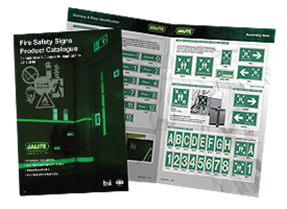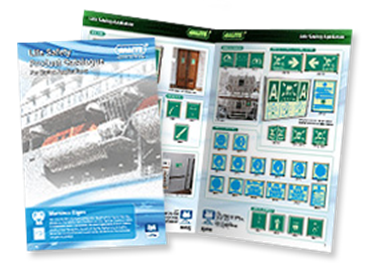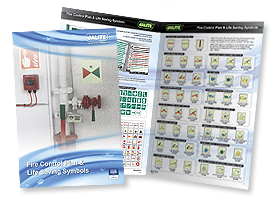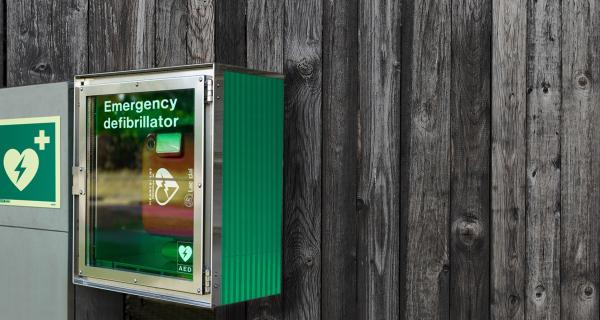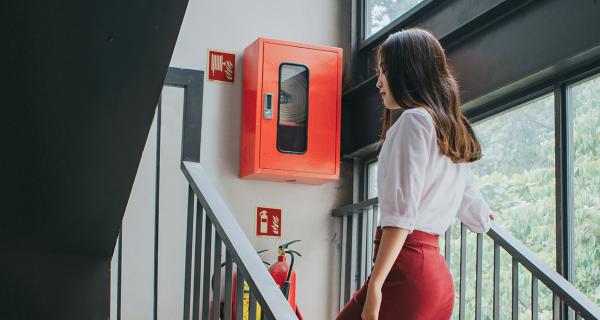Before choosing a supplier of safety signs it is essential to have some knowledge of the risks, the legislations and the standards of best practices for safety signs.
When the lights go out, ours go on.™
Solutions
The year 2000 brought photoluminescent systems to the forefront for emergency light and escape path marking. JALITE Photoluminescent systems offer the unique solution to failsafe emergency light and emergency exit signs under any formal risk assessment.
Read moreOUR CATALOGUES
Fire Safety Signs |
Marine Safety Signs |
FCS Catalogue |
Why choose Jalite ?
A British family owned company with the highest standards and quality in photoluminescent fire safety signs. We pride ourselves on providing you as our valued authorised distributor with continued support for you and your customers. Our customer services team are only a phone call or email away to advise you and assist you.
-
Trust
- Established in 1983
- Family-owned
- Made in Britain
- Fast delivery and lead times
-
Service
- UK based customer services team
- Technical support for BSI and ISO info.
- Marketing and Literature resources
-
Conformance
- 40 years of knowledge of Standards
- In house research and development
- Quality fire safety signs
-
Performance
- Market leading photoluminescent material
- Class C+ luminance performance
- Rigid and vinyl photoluminescent material
-
Compliance
- BS EN ISO 7010:2020
- BS 5499-4:2013
- BS ISO 3864-1:2011
- DIN 67 510 Part 1:2020
Lives depend on how you do your job! Let's do it right and save lives together ! Great solutions for your product needs and outstanding service for all our distributors, your success is our success!
Find a distributor Become a distributorCategories in focus!
Learn about safety
JALITE are committed to keeping our customers informed with all the pertinent news and updates to Legislation, British and International Standards, guidance, special offers and much more. Find these updates below.
Latest articles
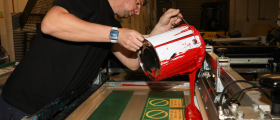
JALITE: Made In Britain
Despite our reach across the world today, JALITE began and grew from the work of one family and small team in Britain. We have been manufacturing JALITE AAA class C+ photoluminescent fire safety signs for decades, helping to protect the life safety of evacuees worldwide. The revolution in fire safety in our earliest days, saw the introduction of legislation designed to protect people and property, especially in industrial, commercial, and marine environments. With new beginnings came a call for guidance and recommendations for the design, commissioning, and installation of fire safety signs. Within the setting of Britain, there was a demand for more prescriptive guidance for fire safety signs, forcing the development of British Standards for fire safety signs that identified, informed, instructed, and located risks. JALITE was positioned to help to inform the British Standards through our in-house research and development of technology, using real life application as our premise. Our background of in-house scientists and marketing professionals, alongside co-ordination with external experts created a recipe for quality technical information to deliver to the fire safety industry. Since, we have used the same principles, working with, and supporting homegrown businesses who also endorse quality, whilst incorporating both international and British requirements for safety. As we mark St. George’s Day this week and celebrate our English heritage as a family run business, we thought we would touch on our commitment to working with other British manufacturers, though our involvement in the Made in Britain community. However, first we thought we would highlight what Made in Britain is and what the trademark represents for consumers and other companies. Who are Made In Britain? Made In Britain is a support for British manufacturers as the trademark helps to verify the origin of British products. In doing so, Made in Britain helps to bring together the manufacturing community, through collaboration with other trade bodies and government departments in the UK. Since its origins in 2013, Made in Britain has worked to promote and celebrate the best in British manufacturing, allowing for transparency for end users looking to get products manufactured on their own doorstep. JALITE authorised distributors through us, are also doing their part to support local businesses. JALITE Photoluminescent Products & Sustainability Made in Britain trademarks naturally encourages sustainability, with homegrown members declaring their manufacturing processes, policies, initiatives, and certifications. Declaration of origins of manufacturing materials and processes is imperative as the world moves towards sustainability in all areas of industry. This is even more integral on British soil, as the UK government commits to ensuring the UK is net zero by 2050. This commitment to removing emissions to lessen the effects of global warming, has rippled to all areas of industry, particularly manufacturing, with policies designed to decarbonise the sector. In addition to working with local businesses as part of our manufacturing process and involvement in Made in Britain, JALITE AAA class C+ photoluminescent material is an alternative sustainable solution to protecting life safety. Our JALITE AAA photoluminescent material negates the need for additional lighting, using existing surrounding lighting for activation, with high optical brightness from even low levels of light. Hence, JALITE photoluminescent fire safety signs help to facilitate the safe egress of evacuees when they need it most. JALITE also use a flame retardant, self-extinguishing recyclable PVC backing for all our JALITE AAA class C+ photoluminescent material. All of this coupled with the JALITE commitment to working with British businesses, subsequently reduces our overall footprint, and yours too by extension. The JALITE team JALITE PLC has always been a UK based customer services team, equipped to provide you all the technical information that is pertinent to you. This includes a collection of marketing literature, instructions on how to install our photoluminescent products, and much more shared exclusively with JALITE authorised distributors. Our UK based customer services team, are up to speed with emerging fire safety legislation to help responsible and appointed persons reach compliance. With this, we can ensure conformance to the guidance that the legislation references as the best code of practice for fire safety signs. JALITE are dedicated to helping you grow your business as we facilitate the justification and specification of JALITE products. JALITE have a UK based production team that have a combined 117 years of experience of manufacturing fire safety signs between them. JALITE printers are some of the few individuals in the UK that are professionals in the dying art of screen printing, producing the best quality print for fire safety signs. This printing style is known throughout the industry to promote durable and legible fire safety signs as required by legislation. This combined with the technical knowledge of phosphorescent pigments and products, produces JALITE AAA class C+ photoluminescent fire safety signs that have a 30+ year shelf life, available in both rigid and vinyl. JALITE PLC despatch team is based in the UK, meaning you can expect standard JALITE products to arrive with you within 1 to 4 working days. Contact us! If you have any questions about Made in Britain or if you need any further information, please contact us at sales@jalite.com or +44 (0)1268 242300.

JALITE Sign Survey!
JALITE Sign Survey! Throughout our 40-year history, JALITE have campaigned tirelessly to impress upon the fire safety industry, the importance of fire safety signs in protecting life safety. Despite the legal requirement for fire safety signs, this vital piece of fire safety equipment has often been an afterthought. For JALITE, fire safety signs are our life. We understand through our own in-house research and development, involvement in setting British and International Standards, and from the outcomes of research into human behaviour during an emergency, how integral fire safety signs are. Moreover, when these signs are designed poorly, installed incorrectly, missing, or unmaintained, the risks to people and property only develop further. JALITE authorised distributors naturally share this same passion for quality fire safety signs, understanding how imperative safety signs are in deterring delays, and allowing evacuees to egress safely with efficiency. JALITE are looking for individuals who through completing sign surveys can be hailed fire safety sign specialists. Essentially, JALITE are looking to support individuals that can specify and/ or install fire safety signs with a methodical approach, with the confidence to advise end users in industrial and commercial and housing settings. These individuals go beyond to exceed recommendations that arise from formal fire risk assessment, working towards both compliance and conformance. In our pledge to get more feedback from you this year to build upon our services for you, we want to hear from you to determine your current capabilities to complete sign surveys. As with this information, we can then filter new business enquiries straight to you. We would also like to know if you would be interested in developing the knowledge necessary for sign surveys, which JALITE plan to facilitate. Below we will provide JALITE sign survey worksheet, with our recommended fire safety signs usually suggested for compliance. The worksheet also doubles as a resource that eases the ordering process with us for the required signs, if applicable. However, before we provide this, we thought we would touch on what a sign survey is and why the are needed. What is a Sign Survey? A sign survey is a comprehensive report to identify safety sign deficiencies within certain areas such as hospitals, factories, warehouses, retail environments etc. Responsible Persons such as building owners will often enlist the help of a sign surveyor, to begin to meet the requirements and significant findings of the formal fire risk assessment, In essence, the sign survey is a way to fulfil compliance of The Health and Safety (Signs and Signals) Regulations 1996, which mandates that safety signs be sited to minimise potential risks based upon the unique hazards of a particular environment. Sign surveys require a specialist confident in their knowledge of fire safety signs, especially as surveying is often conducted within huge multi-level areas with unique and complex potential risks. Thus, surveyors are required to be competent, confident, and knowledgeable to ensure compliance. The sign survey must encourage consistency and uniformity that identifies, informs, instructs, and locates hazards through the following: Designs of signs Location of signs Distances between signs Sign sizes Sign types Safety sign heights. At JALITE we are notorious for combining the compliance to legislation with conformance to Standards for best code of practice, recommending the use of following photoluminescent fire safety signs: Escape route signs. Mandatory signs Prohibition signs Firefighting signs Warning signs. Click Here to open JALITE Authorised Distributor Sign Surveyors JALITE are always inundated with enquires and requests for sign surveys from end users- your potential customers. However, as a manufacturer our only aim is to support our country wide network of authorised distributors by passing such enquiries to those who have individuals that are sign surveyors. Since our beginnings, we have strayed away from competing with our authorised distributors operating fairly by distributing work by region and your existing relationships, to filter enquiries straight to you, to help you further your business. In order to exclusively pass requests for sign surveys straight to you, please let us know if you currently have a sign surveyor on your team. JALITE Sign Survey Training If you are a JALITE authorised distributor that does not currently provide sign surveys and are interested in developing this area of your business, we want to hear from you too please. We are in the process of developing a programme as part of career development, that will equip your team with the competencies needed to complete sign surveys. With demands for Responsible Persons, service and maintenance providers, and installer’s to work together to record competencies, compliance and conformance, JALITE sign survey training is the perfect opportunity to build upon knowledge. In the current climate, it will only provide further confidence for your team, with hopes for building long term business and relationships with your existing and prospective customers. Contact us! If you have any questions about sign surveys or would like to take part in our training as part of career development, please contact us at sales@jalite.com or +44(0) 1268242300 for more information.
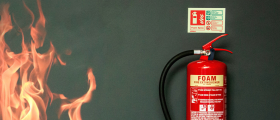
Fire Extinguisher Identification Signs
JALITE Photoluminescent Fire Extinguisher Identification Signs This month has been one for going back to basics, with one of the most prolific fire safety signs for JALITE, the fire extinguisher identification (ID) sign. As we touched on previously, our history and success can easily be tied to our design of the fire extinguisher ID, which became the blueprint for this sign type, widely used today. With popularity of the fire extinguisher ID sign, also came alternative designs for the sign, which went against the very Standards that legislation referenced for guidance. JALITE have informed legislation and contributed to Standards since our origins 4 decades ago, naturally becoming advocates for best practice and quality, in all that we do. This undoubtedly extends to the design and manufacturing of JALITE photoluminescent fire extinguisher ID signs. With this interest in mind, we thought we would highlight the design properties of ID signs, to allow a recap, and to do our part to ensure that Responsible Persons can protect people and property, through specifying and installing compliant and conforming designs. We previously discussed specialised fire extinguisher ID signs. But this week, our emphasis is on standard fire extinguisher ID signs for the tried-and-true fire extinguishers, accepted throughout the industry. Below you’ll find some literature for JALITE fire extinguisher ID signs, a tool for a refresh on fire extinguisher ID signs, especially for new starters. However, we’ll first go into the fundamentals, briefly explaining what fire extinguisher ID signs are and why the signs are needed. Why are Fire extinguisher ID signs Needed? Fire extinguisher ID signs are a vital piece of fire protection equipment that help to locate, identify, instruct, and inform trained personnel, on how to select and operate the fire extinguisher. Fire extinguisher ID signs are designed to meet the unique requirements of The Health and Safety (Signs and Signals) Regulations 1996. In essence, the fire extinguisher ID signs facilitate the mitigation of significant risks to health and safety, therefore people and property, often after recommended after formal risk assessment. In order to appropriately label the fire extinguisher, ID signs must therefore coincide with the classification of fire whether: Flammable solids Flammable liquids Flammable gases Combustible metals Electrical equipment Cooking oils In the event where the fire extinguisher is mislabelled, put in the incorrect place, or labelled with fire extinguisher ID signs that are non-conforming to recommendations, delays can be deadly. Click here to open JALITE photoluminescent fire extinguisher Identification Signs JALITE photoluminescent fire extinguisher ID signs are your solution to combining the requirements of compliance and conformance. Our photoluminescent fire extinguisher ID signs are designed to the colour coding of BS 5306-10;2019 and to BS EN 3, to match the body of the fire extinguisher. To encourage familiarity, and therefore quick response times for trained personnel, JALITE photoluminescent fire extinguisher ID signs also contain the graphical symbol as per BS EN ISO 7010: 2020: A7+2023. JALITE standard photoluminescent fire extinguisher ID signs are available within 1 to 4 working days including: Water- A class wood paper and textiles fires Carbon Dioxide for B class flammable liquids and live electrical equipment fires Foam for A class and B class fires ABC Powder for A, B and C class fires and live electrical equipment fires Wet Chemical for A and F class fires JALITE photoluminescent M2 Powder fire extinguisher ID signs are now updated to the signal violet colour for D class fires, as recommended in BS 5306-10:2019. All JALITE photoluminescent fire extinguisher ID signs are available in our ID size (100 x 150mm) and M size (80 x 200mm), manufactured on JALITE AAA class C+ photoluminescent rigid PVC or self-adhesive vinyl. This undoubtedly helps Responsible Persons and installers to minimise risk, with JALITE photoluminescent signs that help locate, identify, instruct, and inform regardless of lighting and smoked filled conditions. Personalised JALITE Photoluminescent Fire Extinguisher Identification Signs To help you with additional marketing, all standard JALITE photoluminescent fire extinguisher ID signs are easily personalised to feature your company information. Personalised fire extinguisher ID signs can be customised to include the following: Company name Telephone number Email address Barcodes and logos can also be added to standard JALITE photoluminescent fire extinguisher ID signs. Existing JALITE customers of personalised fire extinguisher IDs have found that customisations, encourage repurchase from their existing customers, and new business from perspective customers who can order directly through you. JALITE personalised photoluminescent fire extinguisher ID signs are available to be despatched within 7 to 10 working days. Personalised JALITE photoluminescent fire extinguisher ID signs must be ordered in quantities of 400 pieces of each design. Alternatively, if you prefer to order for your yearly requirements, we can accommodate 12 monthly orders, that can be based on your monthly average orders of fire extinguisher ID signs. Despatch of such purchase orders can be arranged for a set date, for each month (subject to trade indemnity credit facilities). Contact us for more information on JALITE photoluminescent fire extinguisher ID signs, whether personalised or standard. Our customer services team will be happy to help you at sales@jalite.com or +44(0) 1268 242 300 today.
Test your knowledge!!
About us
JALITE has been in business since 1983 with the brand JALITE and we are proud to be the pioneers of all the main applications for photoluminescent 'See in the Dark' safety products.
Over 109 countries
Jalite products have been developed and supplied to over 100 countries in the world and often with safety messages in the local language or with dual language.
